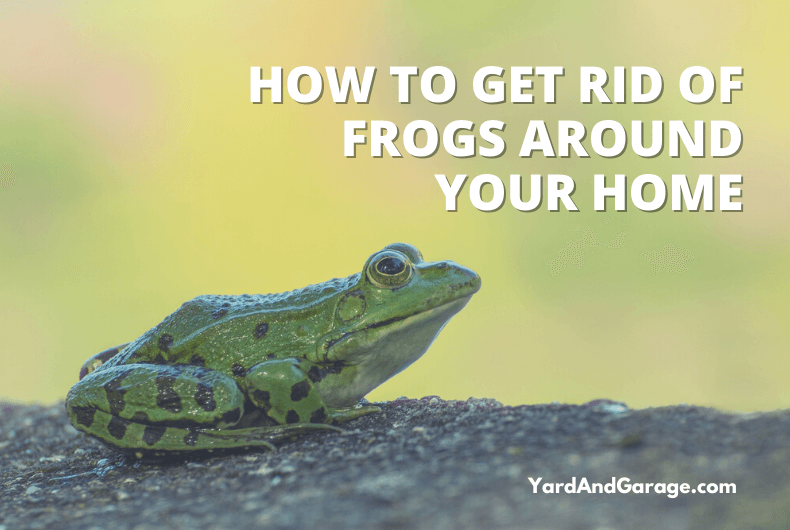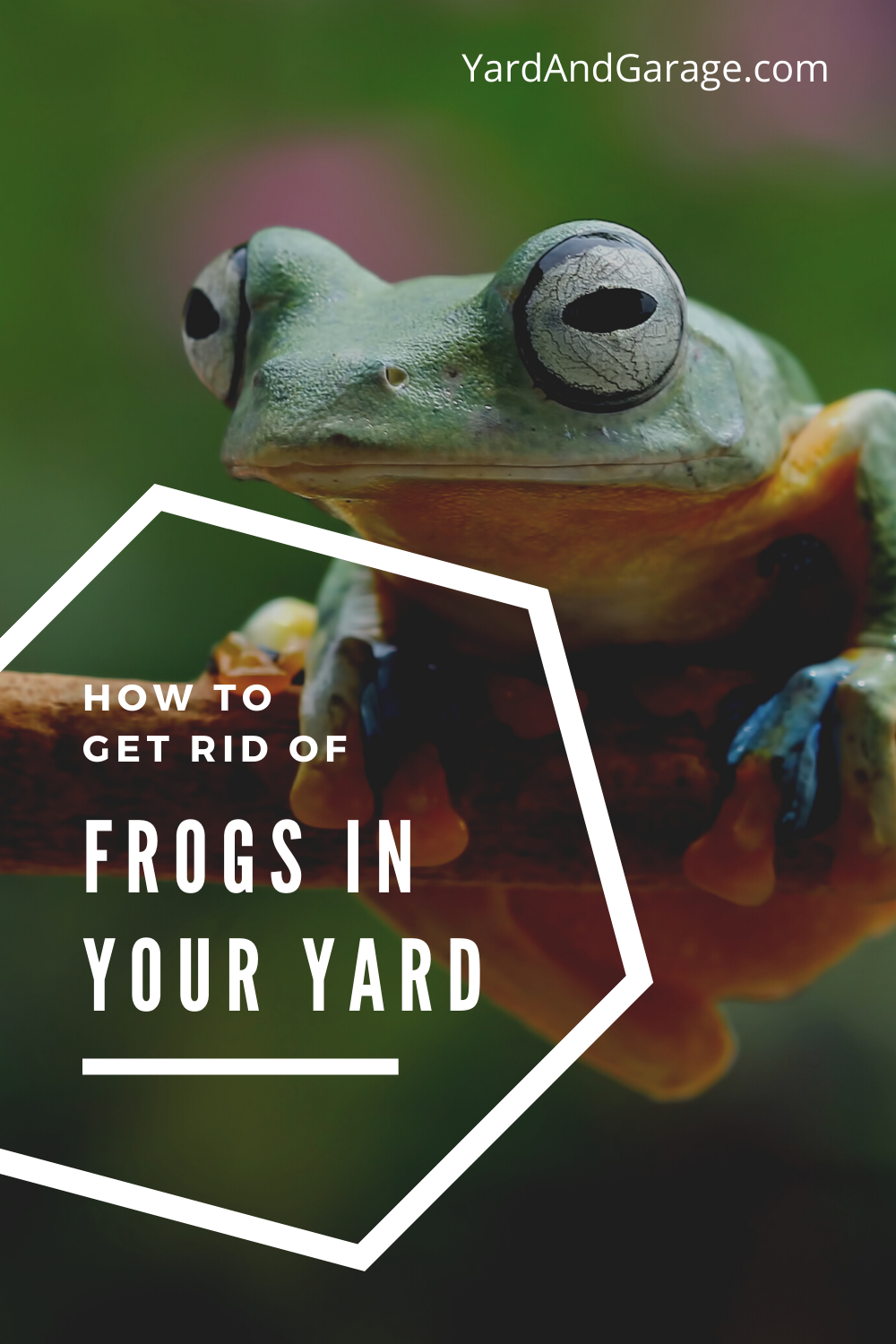
Yeah, we get it. Frogs might be okay as characters in storybooks, but in reality, they can be a nuisance!
Helpless homeowners with frog infestations might have resorted to killing them. Still, we bet it didn’t quite reach the result they were hoping for.
Barring the fact that this may be (arguably) inhumane, it’s not even the most effective way to get rid of these critters invading your home, yard, and pool.
So, how to keep frogs away from your house? You might have scoured hundreds of articles online and tried several DIY methods, but the problem persists.
Getting rid of these pesky creatures may not be the most straightforward task, but our ultimate guide on getting rid of frogs will rescue you from this problem.
Table of Contents
Getting to Know Frogs
Have you heard the statement, ‘keep your friends close but your enemies closer?’ This is also applicable when you want to get rid of frogs forever.
You might kill frogs, but if the factors that attracted them to your property in the first place remain, you will soon find more frogs trespassing on your land. To eliminate frogs for good, you need to know what these creatures are all about.
A frog is categorized as an amphibian with no tail, short arms, smooth skin, sturdy legs, and webbed feet.
Frogs and toads classify as ‘Anura,’ which translates to ‘without a tail.’ But contrary to popular belief, frogs and toads are not the same.
Toads have a squat, short, and stout body with dry, warty skin and crawl as opposed to frogs that can be seen leaping with long legs.
Frogs vs. Toads
Frogs and toads look similar, but they are very different when you get down to their features and characteristics.
This is important to know as your methods to get rid of frogs may be targeted towards toads, which leaves you with no real progress on the issue.
Here are some key differences between frogs and toads.
-
- Skin: This is the primary difference between the two critters. Frogs have smooth and slimy skin, which is often moist since they spend most of their time near/in water. Toads have thicker, bumpy skin, which is dry.
-
- Location: As a result, frogs are more likely to see near properties with water, i.e., pools and ponds. Toads thrive in areas with more dry land, away from water, like pavements and grass.
-
- Shape: Frogs are agile-looking with a pointier shape than toads. Toads are stockier with a stout appearance.
-
- Legs: Frogs have strong and long hind legs that aid them in leaping. Toads have shorter, stouter hind legs that are more suitable for walking or crawling rather than hopping.
-
- Eyes: Frogs have unmistakable, big, bulging eyes. Toads have more subtle eyes.
-
- Spawn: Both lay eggs in water, but frog eggs are in big, gooey clusters while toads lay eggs in long chains.
-
- Poison: All toads are poisonous, with parotid glands behind their eyes that only differ in potency of toxins, but not all frogs are poisonous. The cane toad, in particular, produces highly toxic secretions.
-
- Tongue: Frogs have long, sticky tongues to catch prey. Toads do not have long, sticky tongues and must walk up to food to consume it.
-
- Behavior: A frog is more timid than a toad and might hop away as you approach it. Toads may stand their ground or jump just a short distance.
-
- Tadpoles: Frog tadpoles are slimmer than toad tadpoles, which tend to be chunkier.
Frog Habitats
Frogs thrive in several environmental conditions, from tropical forests to deserts to frozen tundras. Since frog skin requires freshwater, most frogs live in aquatic and swampy conditions near a water source like lakes, ponds, and streams.
They are found on almost every continent except Antarctica. Of course, there are native species of frogs found in specific areas, and then there are invasive species like the Bullfrog.
There are differences even in where those species might be found in your homes. For example, tree frogs are common in the backyard, but they are unlikely to enter the house.
Frogs are found all over the U.S., but they are more common in certain states. Let’s look at the regions where frogs are most to least common.
Frogs are most common in:
- Virginia
- Arizona
- Texas
- South Carolina
- Florida
Frogs are least common in:
- Alaska
- Minnesota
- Hawaii
- North Dakota
- Maine
What Do Frogs Eat?
Frogs are carnivorous amphibians. They will eat anything that fits into their mouth. So expect these critters to devour pesky bugs and flies that might be parading your garden and eating away your plants.
In fact, research shows that frogs help keep the insect population under control. This actually makes frogs quite conducive to homes, as long as they are present in small numbers.
A frog’s sticky tongue will dash out of its mouth to catch its prey. This movement is so fast that it doesn’t even give their game a chance to escape.
Identifying the Frog Species
Suppose you want to get rid of frogs. In that case, you need to know the differences between frogs and toads and the differences between the different species of frogs, like tree frogs, American Bullfrogs, etc.
Understanding the varieties of frogs and how they differ will help you develop a solid game plan to get rid of them, depending on the region where you live. Native frogs and toads include the Cane toad, Gray tree frogs, and Chorus frog.
It’s also vital to know which frog species are endangered so you don’t end up killing them, as this could land you in trouble with the law or neighbors!
The Most Endangered Frogs and Toads in the U.S.
While you may be absolutely done with frogs, going to desperate measures to get rid of them, we’d say give this guide a quick read. Here is a list of the most endangered frogs and toads in the U.S. that you should avoid killing.
California Red-Legged Frog
You can identify these frogs by their distinct reddish-brown color. They have tiger-like stripes on their legs and are robust in size.
They are most abundant in the Western United States. Still, They have recently disappeared from roughly 70% of their original range due to the mass destruction of their habitat.
Sierra Nevada Yellow-Legged Frog
These frogs are yellowish or reddish-brown in color from above, speckled with black or brown spots. They are most common in California, but their existence has dropped in 90% of the water bodies they used to occupy. They would usually be found in aquatic conditions, about a meter from a water source.
Dusky Gopher Frog
DGF is a medium-sized, stocky frog covered in dark spots and warts. It usually has a black, brown, or grey color. This endangered frog hails from Southeastern USA but is only found in one or two breeding spots in Southern Mississippi.
Arroyo Toad
This toad is greenish-grey in color, and interestingly has a ‘smashed’ face similar to a pug. Since this toad is very selective about its habitat, you would only spot it if you lived in Southern California. This toad is under the threat of extinction, so you should be careful that you don’t end up killing the Arroyo Toad if you were to spot it.
Why Do Frogs Croak at Night?
It is no accident that frogs croak at night. What might sound like a nuisance to you is actually meant to be a sweet serenade-a song that male frogs sing to attract female frogs!
So, in essence, a frog’s croak is a mating call. The male frogs will market themselves to female frogs, hoping the latter would hear this ‘call’ and come to them.
But we get it; this doesn’t make the sound any better. Interestingly, every frog species will aim to attract a female frog from its own kind, due to which every kind of frog has a different croak. So you can identify the frog species just by listening to its sound.
Is It Good to Have Frogs Around Your House and Garden?
We get why it’s annoying to hear the constant croaks of frogs in your garden. Some of you might not be fans of these creatures, while others may just be weary.
But let us tell you something. A frog in your garden isn’t always a bad thing! There are pros and cons of frogs around your house, and we’ll talk about it all—the good, the bad, and the ugly.
The Cons of Having Frogs in Your Garden
Your aversion to frogs isn’t entirely baseless. Here are a few disadvantages of frogs in your garden.
Frogs May Be Poisonous
Some species of frogs can be poisonous. Poisonous frogs are usually the ones that are very colorful, for example, the corroboree frog and the poison dart frog.
These frogs produce toxins that are powerful enough to kill humans. Before you freak out, bear in mind that these highly poisonous frogs seldom venture out of their habitat, so there are few chances that you might find one in your home.
These frog types are usually found in pristine rain-forests.
Frogs May Carry Disease
Frogs may carry a host of disease-spreading bacteria, making them highly unsanitary.
Frogs are particularly known to be carriers of Salmonella. This disease could spread through direct or indirect contact, their droppings, or infected water in which they live.
To avoid this, always wash your hands after a visit to a frog-infested area!
Frogs May be Harmful to Pets
Pets, particularly dogs, love to chase frogs. Some frogs might release toxins as a defense mechanism. While these secretions may not be deadly, they could potentially upset your pet’s digestive system. To avoid this, you should keep your pets out of a frog’s line of sight.
The Pros of Having Frogs in Your Garden
You’d be surprised to learn that frogs relay more benefits to your home than dangers! Here are some advantages of frogs in your garden.
Frogs Act as Natural Pest Control
Frogs are an integral part of the food chain. They help keep the pest population under control as bugs and insects are literally a frog’s prey!
Frogs are particularly useful for protecting the fruits or vegetables in your garden from pesticides.
Suppose you have pesky insects parading through your home at night. In that case, frogs will offer their pest control service to you, capable of devouring thousands of insects and flies in just one night.
Frogs are Bioindicators
Frogs are extremely sensitive to environmental disturbance, which is why they are perfect bioindicators. If you spot a frog in your yard, this means that your garden is prospering—a sign of a healthy ecosystem!
However, don’t be alarmed if you can’t spot any frogs in your garden, as their presence keeps fluctuating with seasonal changes. They should be spotted in mild, rainy weather.
Tadpoles Help Keep Water Clean
If you spot tadpoles in your pond or pool, don’t be so worried. Tadpoles feed on algae, which helps clean any water source in your home.
Without this tadpole regulation, algae will start to grow at an alarming rate, which will pretty soon colonize your entire pond, and that’s the last thing homeowners want.
Frogs Help Sustain the Food Web
If you spot a frog in your garden and allow it to thrive, you’re doing a service to this planet. With the mass extinction of amphibians, the whole food web is disturbed.
Frogs are a significant food source for several animals like snakes, dragonflies, birds, and fish. Their existence is crucial to our planet, giving rise to the ‘Save the Frogs’ movement.
How to Keep Frogs Away?
You may have tried several methods of getting rid of frogs but failed because eliminating them is not an easy or over-the-night task.
However, given the vast frog population, you should research and then draft a long-term plan to eliminate these creatures rather than impulsively kill them.
You might kill ten frogs on your property, but ten more will soon appear if you don’t address the root cause!
So now, let’s talk about sustainable and long-lasting ways to get rid of frogs in your garden and pool.
Ways to Keep Frogs Away From Your House
Given how frogs are vital to the planet and the rapid rate at which frog species are endangered, it is a plea to all homeowners to exercise some consideration when getting rid of frogs.
There are plenty of humane ways to keep frogs away from your home, as listed below.
Get Rid of Their Food Source
The first step to getting rid of frogs is eliminating their food source, including crickets, flies, moths, and worms. Spray insecticide on plants and vegetation that may attract these pests.
Since frogs find flies to be their best prey, make sure you set up mosquito traps to get rid of these insects for a frog and bug-free garden.
Switch Off Outside Lights
You may have noticed a swarm of flies around lights, especially at night, and that’s literally what attracts frogs to your yard.
Frogs have to fend for food, so when they find a place with flies and mosquitoes, they quickly make themselves at home. To make your ground less attractive to frogs, switch off outside lights where a frog’s prey tends to linger.
Ensure Proper Water Drainage
Frogs need considerable water to stay alive and reproduce. Ensure proper drainage in your garden to make a frog’s survival on your property difficult. Frogs enter land but prefer going back to the water after a while to lay eggs and multiply.
Make sure you remove standing water from your property and add a frog-proof mesh over your pond or pool.
Get Rid of Tall Weeds and Grass
We talked about a frog’s behavior to let you know that these critters are easily scared as you approach them.
Due to this timid nature, they like to hide behind tall weeds and grass on your property. Tree frogs tend to camouflage in trees. Frogs also prefer privacy to lay eggs.
If your lawn has tall plants, expect to find frogs seeking shelter there. Trim your garden to make your home inhospitable to these unwelcomed guests.
Install Window Screens
Frogs may venture inside your home from your garden, especially if you tend to keep your windows open for some ventilation. Add window screens to keep frogs from entering your house. Regularly check window screens for any holes or tears before a sneaky frog manages to enter.
Get Rid of Tadpoles
If there is a frog on your property, it can lay thousands of eggs near or in the pool or pond. When these eggs hatch, tadpoles will emerge, which will then grow into frogs – several frogs!
If you want a frog-free zone, put an end to their life cycle at an early stage. Use a net to scoop out the tadpoles and leave them in a faraway pond or water body.
Use Salt
Frogs have wet skin, so they experience a burn-like effect when their feet or skin touches salt. So sprinkle a little salt around your property, the pond or pool, and under shrubs to prevent frogs from entering your premises.
Use Coffee Grounds
Frogs hate coffee grounds just as much as salt, so this is another way to keep them off your property.
Sprinkle coffee grounds around your property to prevent the entry of frogs and enjoy the added benefit of that fantastic coffee scent!
Use Vinegar and Water Spray
If you’re looking for other home remedies, add equal parts of vinegar and water to spray around your property.
Frogs experience a burning sensation when they step in vinegar, so this is a foolproof way to keep them away from your house.
Use Lemon Juice Spray
You can also use any diluted citric juice to spray around your property and frog-infested areas. Lemon juice puts off frogs the same way vinegar does, so frogs won’t even enter your property, let alone reside in it.
Use Snake Repellent
A snake repellent contains the same ingredients as mothballs, which repel frogs. Since frogs attract snakes, using a snake repellent around your property will successfully ward off frogs and snakes from your house.
Add a Barrier Around Your Property
Another way to keep frogs from entering your house is by adding a barrier around your property. Make sure the barrier does not have any large holes that frogs and toads may squeeze through.
Create a Frog-Friendly Spot
If you want to limit frogs to your garden, you can create a frog-friendly spot there. This will help keep them away from the windows of your house.
Sprinkle some salt or vinegar around this spot to restrict frogs to that assigned area.
Introduce Natural Frog Predators
Add natural predators to your property to act as frog repellents. Cats and snakes prey on frogs, but it is best to research the frog species you’re dealing with. Make sure the frog isn’t poisonous, or it may be life-threatening for your cat.
Ways to Keep Frogs Out of Your Pool
Frogs love water, so homes with pools and ponds naturally attract these amphibians. However, frogs may carry disease and tend to lay eggs in water, so you want to keep them away from your pool. Here are a few ways to do that.
Turn Off Pool Lights
Some people keep the pool light on for security. However, any light source is bound to attract flies, the number one prey for frogs.
Turn off your pool lights to keep frogs from entering your pool in the hope of some food.
Use a Pool Cover
Your pool lights may be off, but water will still attract frogs. Use a pool cover at all times when the pool is not in use to prevent frogs from entering.
Add an Exit Ramp
Frogs that enter the pool may not be able to find a way out, so add an exit ramp like frog logs or a bodyboard to help these slimy creatures get out. This won’t prevent frogs from entering the pool, but it will reduce the number of dead frogs you have to scoop out.
Install a Fence Around the Pool
Unless it starts to rain frogs, a 2-3 inch tall fence bordering the pool will keep frogs from entering the pool area. Make sure this fence does not have any opening that frogs can get through.
Get Rid of Tall Grass
If there are frogs in your garden, they’ll eventually find a way to your pool. Frogs use tall grass and thick weed patches as hiding spots, so make sure you keep your lawn mowed at all times.
Use DIY Frog Repellent
Many ingredients from your can kitchen repel frogs. Spray vinegar or lemon juice around your pool to ward off frogs. You can also sprinkle salt around the pool. When frogs feel any of these elements, they will dart away in search of another water body.
Keep Water Moving
Frogs are a stickler for stagnant water, which also helps them lay eggs. Keep water circulating with a pool fountain or waterfall to prevent your pool from becoming a breeding ground for frogs.
Keep the Pool Heated
Frogs absorb oxygen via the skin, so they prefer to sit in highly oxygenated water. The colder the pool water, the higher the level of oxygen in it, which serves as the perfect invitation for frogs. Use a pool heater to keep frogs from settling in hot pool water.
Keep the Pool Very Clean
A dirty, algae-filled pool will closely resemble a pond, the natural habitat of frogs! So ensure your pool is sparkling clean at all times to make it less conducive to these slimy creatures.
Safety Considerations
There you have it! This guide tells you all about frogs and how to effectively get rid of them. Note that some people may have frog allergies that they may not even know about.
This can cause mild to severe reactions, so it is advisable that you wear gloves, socks, and closed shoes before you come in contact with frogs. No part of the skin should be exposed to the frog’s skin or any surface that the frog may have touched.
If you have exhausted all the options mentioned above or are faced with a severe frog infestation that you need to get rid of ASAP, get the services of a pest control company.
Even if all else fails, this serves as the most cost-effective and hassle-free way to get rid of frogs from your house and pool quickly.



